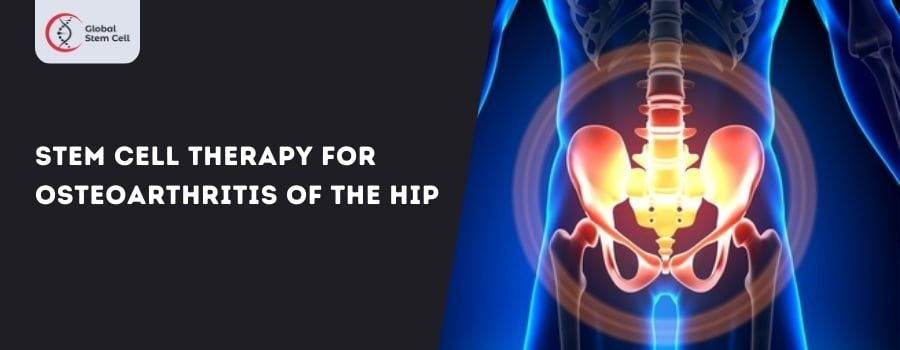
Hip Osteoarthritis Treatment with Stem Cell Therapy
Table of Content
Osteoarthritis (OA) is a degenerative joint disease that affects millions of people worldwide, causing pain, stiffness, and reduced mobility. Among the various joints susceptible to OA, the hip joint is particularly prone to wear and tear due to its pivotal role in supporting body weight and facilitating movement.
Traditional treatments for hip osteoarthritis include pain medications, physical therapy, and in severe cases, joint replacement surgery. However, a promising and innovative approach has emerged on the horizon – stem cell therapy.
Understanding Osteoarthritis of the Hip
Before delving into the potential of stem cell therapy, it’s crucial to comprehend the nature of osteoarthritis and how it affects the hip joint. Osteoarthritis is characterized by the breakdown of cartilage, the protective tissue that cushions the ends of bones in a joint. As the cartilage deteriorates, bones rub against each other, leading to pain, swelling, and decreased joint function.
The hip joint, being a weight-bearing joint, is vulnerable to osteoarthritis, especially in individuals over the age of 50. Factors such as aging, genetics, joint injuries, and obesity contribute to the development and progression of hip OA. The conventional treatments mentioned earlier often provide symptomatic relief but may not address the underlying cause of cartilage degeneration.
What is Stem Cell Therapy?
Stem cell therapy has gained attention as a groundbreaking approach to treat various medical conditions, including osteoarthritis. Stem cells are undifferentiated cells with the remarkable ability to transform into specialized cell types, such as cartilage, bone, or muscle cells. This regenerative potential makes them an attractive option for addressing the damaged cartilage in hip osteoarthritis.
Types of Stem Cells Used in Therapy
There are different types of stem cells utilized in regenerative medicine, each with its unique characteristics and potential applications. The two main categories relevant to osteoarthritis treatment are embryonic stem cells and adult stem cells.
- Embryonic Stem Cells: Derived from embryos, these cells have the ability to differentiate into any cell type in the body. While they possess immense regenerative potential, ethical concerns and the risk of uncontrolled cell growth limit their use in clinical applications.
- Adult Stem Cells: Also known as somatic or mesenchymal stem cells, adult stem cells are found in various tissues throughout the body, including bone marrow, adipose tissue, and synovial fluid. These cells can differentiate into specific cell types, making them a safer and more ethically acceptable option for therapeutic use.
Stem Cell Therapy Procedure for Hip Osteoarthritis
Stem cell therapy for hip osteoarthritis typically involves the extraction of adult stem cells from the patient’s own body. The most common sources include bone marrow and adipose (fat) tissue. The procedure can be outlined in several key steps:
Stem Cell Extraction
- Bone Marrow Aspiration: A small amount of bone marrow is extracted from the patient’s hip bone using a needle.
- Adipose Tissue Harvesting: A minimally invasive liposuction procedure is performed to obtain a small amount of fat tissue from the patient.
Isolation and Processing
The collected tissue undergoes processing to isolate the stem cells from other components. This may involve centrifugation or other specialized techniques.
Cell Injection
The concentrated stem cells are injected directly into the affected hip joint, guided by imaging techniques such as fluoroscopy or ultrasound.
Regeneration and Healing
Once injected, the stem cells promote tissue repair and regeneration by differentiating into cartilage cells and releasing growth factors that stimulate the body’s natural healing processes.
Benefits of Stem Cell Therapy for Hip Osteoarthritis
- Regeneration of Cartilage: The primary goal of stem cell therapy is to regenerate damaged cartilage. Stem cells can differentiate into chondrocytes, the cells responsible for producing cartilage, leading to the formation of new, healthy tissue.
- Anti-Inflammatory Effects: Stem cells possess anti-inflammatory properties, helping to reduce the inflammation associated with osteoarthritis. This anti-inflammatory effect contributes to pain relief and improved joint function.
- Minimally Invasive: Compared to traditional surgical interventions like joint replacement, stem cell therapy is a minimally invasive procedure. This means less trauma to the body, shorter recovery times, and reduced risk of complications.
- Autologous Treatment: Using the patient’s own stem cells reduces the risk of rejection or adverse reactions. Autologous treatments also alleviate ethical concerns associated with the use of embryonic stem cells.
- Symptomatic Relief: Stem cell therapy not only targets the root cause of osteoarthritis but also provides symptomatic relief. Patients often experience a reduction in pain, increased joint flexibility, and an improved quality of life.
Clinical Evidence and Research
The effectiveness of stem cell therapy for hip osteoarthritis is supported by an increasing body of research and clinical studies. While the field is still evolving, several studies have reported positive outcomes, demonstrating the potential of stem cells in treating osteoarthritic conditions.
- A Randomized Controlled Trial: A randomized controlled trial published in the Journal of Bone and Joint Surgery compared the outcomes of patients with hip osteoarthritis treated with either hyaluronic acid injections or mesenchymal stem cell injections.
- Long-Term Follow-Up: Long-term follow-up studies have shown sustained benefits of stem cell therapy in hip osteoarthritis patients. Improved joint function and reduced pain persisted over several years, suggesting the regenerative effects of stem cells.
- Meta-Analyses: Meta-analyses pooling data from multiple studies have provided further insights into the overall effectiveness and safety of stem cell therapy for osteoarthritis. While more research is needed, these analyses indicate a favorable risk-benefit profile.
Challenges and Considerations
While stem cell therapy holds great promise, it is essential to acknowledge the existing challenges and considerations associated with this emerging treatment modality.
Limited Regulation: The field of stem cell therapy is still evolving, and there is a lack of standardized protocols and regulations. This can lead to variations in the quality and consistency of treatments across different clinics.
Variable Outcomes: The response to stem cell therapy can vary among individuals. Factors such as the severity of osteoarthritis, the patient’s overall health, and the quality of the stem cell preparation can influence the outcomes.
Costs and Accessibility: Stem cell therapy is often considered a high-cost treatment, and its accessibility may be limited for some patients. Insurance coverage for these procedures may also be a challenge.
Ethical Concerns: While adult stem cells alleviate many ethical concerns associated with embryonic stem cells, questions regarding the ethical use of stem cells in general still exist. Ensuring informed consent and ethical practices in research and treatment is crucial.
Future Directions and Emerging Technologies
As research in stem cell therapy for hip osteoarthritis continues, several exciting developments and emerging technologies are shaping the future of regenerative medicine.
Advanced Cell Culture Techniques: Innovations in cell culture techniques are enhancing the isolation and expansion of stem cells, improving the overall quality and potency of the therapeutic cells.
Combination Therapies: Researchers are exploring the potential of combining stem cell therapy with other treatment modalities, such as growth factors, platelet-rich plasma (PRP), and tissue engineering, to enhance the regenerative effects.
Personalized Medicine: Advances in understanding the genetic and molecular factors influencing osteoarthritis may pave the way for personalized stem cell treatments tailored to individual patients.
3D Printing and Tissue Engineering: 3D printing and tissue engineering technologies are being investigated for creating scaffolds and structures that mimic the natural environment of joints, providing a supportive framework for stem cell integration and tissue regeneration.
Stem cell therapy represents a promising frontier in the treatment of hip osteoarthritis, offering a regenerative approach to address the underlying causes of the disease. While research and clinical studies continue to validate its efficacy, it is crucial to approach this treatment modality with a balanced perspective, considering both the potential benefits and existing challenges.





